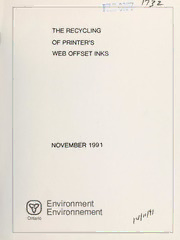
The Recycling of Printer's Web Offset Inks PDF
Preview The Recycling of Printer's Web Offset Inks
ISBN 0-7729-8999-0 THE RECYCLING OF PRINTER'S WEB OFFSET INKS Report prepared for: Waste Management Branch Ontario Ministry ofthe Environment Report prepared by: A.A. Wakeford, C.A., Treasurer Proactive Recycling Inc. NOVEMBER 1991 o PRINTIDON flECVCLEOPAPER IMPRIMESUR OUPAPIERRECYCli Cette publication technique n'est disponible qu'en anglais. Copyright: Queen's Printer for Ontario, 1991 This publication may be reproduced for non-commercial purposes with appropriate attribution. pros 1732 DISCLAIMER This report was prepared for the Ontario Ministry of the Environment as part of a ministry-funded project. The views and ideas expressed in this report are those of the authors and do not necessarily reflect the views and policies of the Ministry of the Environment, nor does mention of trade names or commercial products constitute endorsement or recommendation for use. with the assistance of theSR's program we have brought to the printing industry the beginnings of an environmentally rational approach to waste management. As with any pilot project with undeveloped and untested technology there have been hurdles to cross and problems to solve. We are happy to report the continuing successful development of our mobile ink recycling unit. To fully understand what is successful developnent, one must consider the problems and objectives of the project at its outset. The technology of low quality, fixed station, capital and labour intensive recycling equipment existed before the project began. What did not exist was equipment light enough, efficient enough and compact enough to establish a mobile service. The result was very little recycling of this waste type. Only waste from large producers was recycled and it carried a stigma of being an inferior product. There existed two major obstacles; the technological hurdle of mobility and quality and the psychological hurdle of the perception of recycled products being inferior. Technology for a mobile system is considerably different than that of fixed station. From a physical point of view, there are strict height, width, breath and weight restrictions. From a commercial stand point processing time is of the essence. Recycling is the only function of this operation; there are no other factory duties that our men can attend to as the machinery operates. Our technical objective had to be the development of equipment which was fast, small and light. In addition to this, since we would be attending a wide variety of printers, each with theirown housekeeping habits, the system had to be versatile enough to handle a wide spectrum of contamination levels. To say that these goals were difficult to achieve is, in our opinion, an understatarient. During our first two years equipment was modified, tested, torn apart and re-modified innumerable times. Our stated goal was the processing of 540 kilos of ink within 25 minutes. Our actual initial performance was 60 kilos per hour. At this rate coniDercial viability was impossible. To achieve oonmercial viability required improvements to both the speed and quality of production. This was achieved through the addition of multistage processing and the refining of processing procedures. The environmental results are most encouraging. Todate v^ have kept over 117,000 kilos of ink from being buried in a hazardous waste landfill site. Not to mention the hundreds of pages of manifesting forms which no longer have to be generated. But this is just a beginning. As ve defeat the perception that recycled is inferior we continue to sign additional major printers. We have entered the final stages of Phase I, the development of a full four colour heat/cold set ink recycling system. We are currently now developing a program which will promote recycling of this waste by small generators; those generators could not afford to recycle in the past. We are also expanding the types of ink we recycling to include, sheet fed inks, forms ink and waterbase inks. Regardless of the program the success revolves around three prime components. One, the cost and concern of landfilling hazardous waste; two, the cost savings provided by the recycling of ink previously thrown out; and three, the quality of the recycled product. The increasing cost of landfilling hazardous waste has enhanced the cost effectiveness of recycling. By making the producer/user pay the cost of disposal one ensures that these costs are borne by the benefactor not by the unfortunate people living down stream or those drinking water near uncontained landfill sites. The increased awareness of our contnunity members has ensured that these services are discussed, promoted and embraced. Features regarding our nampany and its recycling successes have appeared in no less than five major industrial journals and two interviews with the CBC radio network. Articles regarding this project have been syndicated across Canada. We have been nominated by the Mayor of the City of Owen Sound as a candidate for the Manning Award which recognizes innovative Canadian achievements. Coupled with the avoidance of landfill costs is the cost savings inherent in the recycling of ink. Corporately, ve firmly believe that any recycling program must make the best use of our Provinces limited resources. In environmental terms, if it cost tvrenty units of air polluting power to recycle one unit of ground polluting ink then there is no savings to the consumer, industry or the environment. It is a must that the recycling process be efficient enough to produce immediate and tangible cost savings to all three parties. As a small company with low overhead costs, v^ have achieved an efficiency which allows us to recycle heat-set ink for approximately $2.50 per kilo. Virgin ink costs approximately $4.40 for black to $6.00 for the higher value yellows. We have met, in high order, the requirement of dollar cost savings.
